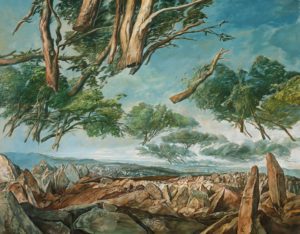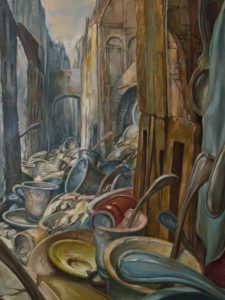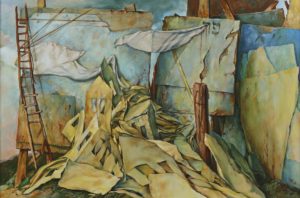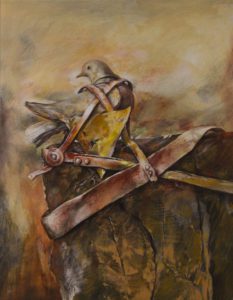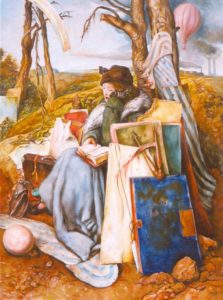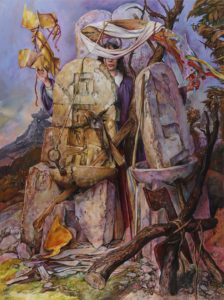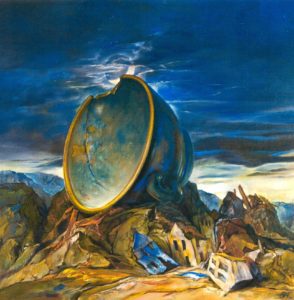The Samuel Bak Collection
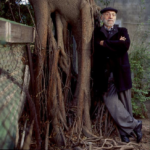
ABOUT THE ARTIST
Samuel Bak was born in 1933 in Vilna, Poland at a crucial moment in modern history. From 1940 to 1944, Vilna was under Soviet and then German occupation. Bak’s artistic talent was first recognized during an exhibition of his work in the Ghetto of Vilna when he was nine years old. While he and his mother survived, his father and four grandparents all perished at the hands of the Nazis. At the end of World War II, Bak fled with his mother to the Landsberg Displaced Persons Camp, where he enrolled in painting lessons at the Blocherer School in Munich. In 1948, they immigrated to the newly established state of Israel.
Bak studied at the Bezalel Art School in Jerusalem and completed his mandatory service in the Israeli army. In 1956 he went to Paris to continue his education at the École des Beaux Arts where he received a grant from the America-Israel Cultural Foundation to pursue his artistic studies. In 1959, he moved to Rome where his first exhibition of abstract paintings met with considerable success. In 1961, he was invited to exhibit at the “Carnegie International” in Pittsburg, followed by solo exhibitions at the Jerusalem and Tel Aviv Museums in 1963. It was subsequent to these exhibitions that a major change in his art occurred.
Samuel Bak painting in Landsberg Displaced Persons Camp. Photo credit: United States Holocaust Memorial Museum, courtesy of Samuel Bak
There was a distinct shift from abstract forms to a metaphysical figurative means of expression. Ultimately, this transformation crystallized into his present pictorial language. Bak’s work weaves together personal history and Jewish history to articulate an iconography of his Holocaust experience.
Across seven decades of artistic production, Samuel Bak has explored and reworked a set of metaphors, a visual grammar and vocabulary that ultimately raises questions. His art depicts a world destroyed, and yet provisionally pieced back together, and preserves memory of the twentieth-century ruination of Jewish life and culture by way of an artistic passion and precision that stubbornly announces the creativity of the human spirit. Since 1959, the artist has had numerous exhibitions in major museums, galleries, and universities throughout Europe, Israel, and the United States including retrospectives at Yad Vashem Museum in Jerusalem, and the South African Jewish Museum in Cape Town. Bak has been the subject of numerous articles, scholarly works, and fifteen books; most notably a 400-page monograph entitled Between Worlds. In 2001 he published his touching memoir, Painted in Words, which has been translated into several languages. He has also been the subject of two documentary films and was the recipient of the 2002 German Herkomer Cultural Prize.
Hear Samuel Bak’s remarks upon receiving his recent honorary doctorate from the University of Nebraska Omaha:
Oil on canvas
Permanent collection of The Florida Holocaust Museum, given in honor of Marc Skvirsky and Mary Keber by Josee and Samuel Bak and Sue and Bernie Pucker in friendship
Part of a series, Under the Trees is an unorthodox yet a beautiful landscape where trees are uprooted and cut off to reveal thousands of gravestones. The unmarked stones, some marred with bullet holes, signify the violence endured by European Jews at the hand of the Nazis during World War II and memorialize the artist’s father who was murdered in a mass shooting in the forest of Ponary, outside the city of Vilna, Lithuania.
Oil on canvas
Permanent collection of The Florida Holocaust Museum
To the Gate shows a strange cityscape, where the streets are emptied of the city’s inhabitants and replaced by objects they left behind. Samuel Bak was born in Vilna, Lithuania, a city so abundant in Jewish culture, it was sometimes called the “Jerusalem of Lithuania.” Before the war, around 70,000 Jewish people lived in the city. Less than 5,000 returned to the city after the war. After the Germans occupied the city in June of 1941, they instituted a series of anti-Jewish decrees and in July murdered 5,000 Jewish men in the Ponary forest which was just outside the city. By the end of the year, the Germans killed 40,000 Jews in the forest.
In the fall of that year, two ghettos were established and the city’s remaining Jewish inhabitants were forced from their homes and into the confines of the ghetto. Bak recalls the experience of being removed from his family’s home and forced into the ghetto in To the Gate and in this description of his experience:
“On the day in which Mother and I were expulsed from our home and forced to march with the other Jews of Vilna to the gate of the ghetto, it rained, and the sky was very dark. Holding on to a few essential belongings, we were soaked, disoriented and dumbstruck. Shivering of cold, we formed a most miserable line of tens of thousands of people. Were we being marched to our death? We have lost everything. Our dispossessed domesticity had been thrown out into the streets, not unlike broken china. Our hopes were gone. The promises of the silver spoons (with which we seemed to have been born) came to nothing. The world did not seem to care. In our eyes, the streets of the gentiles were bathed in sunlight. ” Samuel Bak 2007
Oil on canvas
“The painting belongs in the artist’s ‘PO-NER’ memorial candle series. It speaks of the need to preserve memory, to mark it by the creation of a ritual space.
Ponary (or Ponar) is the name of a wood near Vilna, which holds the mass graves of the city’s Jews. Bak’s father, grandparents, and many of their friends had been murdered there. PO in Hebrew means HERE. These two letters are often found on Jewish tombstones. NER in Hebrew means candle. Heaped up at the foot of a stone candle are the facades of paper houses. Houses of precarious existences. The winds of the war had strewn them like dead leaves. To the light of the canvas, the yellow Star of David underlines the full meaning of the picture.
“An artificial sky has been pasted on wooden panels. Remnants of praying shawls or shrouds seem to be floating on it like clouds. But behind them is a real sky. A ladder, hastily put together, seems to be offering an escape. But one can see in it a different purpose. It might be awaiting God’s messengers; angels that will explain the unexplainable, and carry back to the almighty our thanks, our prayers, or our un-forgiveness.” (L. Langer)
Mixed media on paper
A gift of the Artist and Pucker Gallery in honor of Rimantas Stankevicius
Bak’s works contain a unique language where symbols carry multiple meanings. In this work, the artist remembers his father Jonah, which also means dove. His father was one of over 75,000 Jews who were killed in Ponary, the forest outside of Vilna, Lithuania. In this work, Bak gives his father a gravestone and in the Jewish tradition, places a stone, in the shape of a dove, on top of it, to mark his remembrance. At the same time, the dove is bound to the stone by the Jewish Star of David which European Jews were forced to wear under the Nazis.
Throughout his lifetime, Bak has painted works based on Albrecht Dürer’s Melencolia I (1514). The original engraving features a brooding angel-like figure surrounded by the trappings of theology, science, and philosophy. In Testimonials, the angel is a well-dressed woman who appears to be waiting to depart on a long-awaited trip, perhaps leaving on the train approaching in the background. By including the crematoria chimneys, the painting hints that she may be bound for Auschwitz-Birkenau.
In the Bible, angels are often messengers of God, but in this painting, the angel’s book and canvases are blank. The rainbow symbolizing God’s promise is incomplete. What message does she have to impart?
Permanent collection of The Florida Holocaust Museum, generously donated by a Canadian who is trying to increase awareness of the reprehensible tendency of nations to commit genocide
Lady Justice holds the Hebrew letter tsade for “righteous person” in one hand and, in the other, a broken rainbow. She is hidden by the fractured tablets of the ten commandments. The letter vav, the sixth letter in Hebrew stands for the sixth commandment “Thou shalt not murder” and invites us to think about the connection between biblical law and mass murder. In the background we see the outline of a ship on a mountain top, perhaps the SS St. Louis, the modern ark that was meant to bring Jews to safety in Cuba in 1939. Its smokestacks are a sobering reminder that Sobibór and Auschwitz, not Cuba or the US, were the final ports of call for many of the St. Louis’s passengers.
Oil on canvas
Permanent collection of The Florida Holocaust Museum, given in honor of Gordon Freeman by Josee and Samuel Bak and Sue and Bernie Pucker in friendship
In sharp contrast to the idea of a cup that overflows with abundance is the gigantic empty cup resting atop a rocky outcrop in New Moon for Old Landscape whose vast internal space resembles a cosmos empty of content, perhaps a reflection of the universe before the moment of creation. But this notion is quickly dispelled by the adjacent cluster of abandoned ghetto buildings. What spilled out of this enormous vessel of pain was not a new beginning but an old ending, the vestiges of a destroyed Jewish community — a familiar visual refrain in many of Bak’s earlier works. (Langer):
These massive ruins, however, should not be allowed to eclipse some of the remarkable aesthetic achievements of this intricate work. The enameled outer surface of the cup remains intact, lustrous in the dusk. The cup’s cracked rim conceals a barely visible crescent moon gleaming through the clouds, bathing the landscape with a spectral glow. One would like to say with “a spectral spiritual glow” but there is no evidence to support such a welcome conclusion. Instead, nature proclaims its indifference to the human scene below. The foreground is dominated by a bizarre “still life” (though “still death” might be a more exact description), while above the clouds drift by — are they gathering or dispersing? — and the moon may grow fuller in nights to come. Nothing, however, will restorehuman voices to the cone of silence within the rim of the cup, which is aimed like a giant acoustic ear toward distant planets as if it were listening for some quiver of response to its mute appeal. Whether waxing or waning, the moon’s round shape retains its circular perfection in the heavens. But not all circles are perfect: the cup’s rim has lost its ideal form through some accidental fracture that, if we heed the human ruin nearby, must be part of man’s fate on earth. We are left with the spectacle of a marred beauty, a damaged memory, less inclined to celebrate than to mourn.

